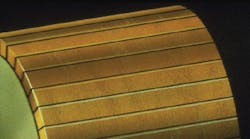Preventive maintenance maximizes uptime while controlling costs.
Maintenance crews strive to reduce maintenance costs and manage their workloads more effectively. Since DC machines require more attention than their AC counterparts, DC maintenance can help achieve both goals. Time-saving tips include changing brushes, checking winding insulation with a megohmmeter, and machining commutators in place. Knowing when to perform this maintenance is the key.
Too little brush spring tension increases resistance across the brush-commutator connection, generating excess heat. But it's easy to measure and correct. Attach a spring scale to the brush shunts and pull. When the brush lifts, slowly release the tension until it begins moving down. The pressure at this point is the spring tension.
Next, calculate the brush pressure. Multiply the thickness of a single brush by its width to find the square area. Divide spring tension by brush area to get brush tension. For most applications, brush pressure should be 4 psi to 6 psi. Traction motors are subject to higher vibration levels and should have brush pressure of 6 psi to 8 psi.
Current density and brush grade Each carbon brush grade is designed to carry a specific current. High-current density increases the operating temperature of carbon brushes. Current density that's too low causes rapid brush wear. In extreme cases, brushes can dust, or wear out, in days. To determine current density, measure the cross-sectional area of the brush surface. Think of the brushes as a group of series-parallel conductors. Since half of them constitute a parallel path for the armature current, those brushes share the total armature current. Base the calculations on actual, not nameplate, current.A simple trick to increase brush density involves removing half of the brushes from the machine. When doing so, it's vital to remove the same brush position from each brush holder row. For a load that varies frequently, discuss the range of loading with your brush supplier.
Electrical balance Brushes play an important role in keeping the machine electrically balanced. Brushes of negative polarity deposit material on the commutator, and those of positive polarity remove material. To maintain this balance, the number of positive and negative brushes in each circumferential brush path must be equal. Keep spares on hand. DC motor performance suffers when you mix brush grades.By monitoring the condition of DC motors, you can spot and correct developing problems during regular maintenance, saving time and money. Changing weak brush springs or correcting a problematic air supply is much easier than replacing a motor.
It's much more effective to treat the root of a problem than the symptom. When it takes five people one shift to change a motor, every DC motor replacement avoided is like a week in the bank. And that's a week better spent on other maintenance issues.
Yung is a technical support specialist at the Electrical Apparatus Service Association (EASA), St. Louis.



